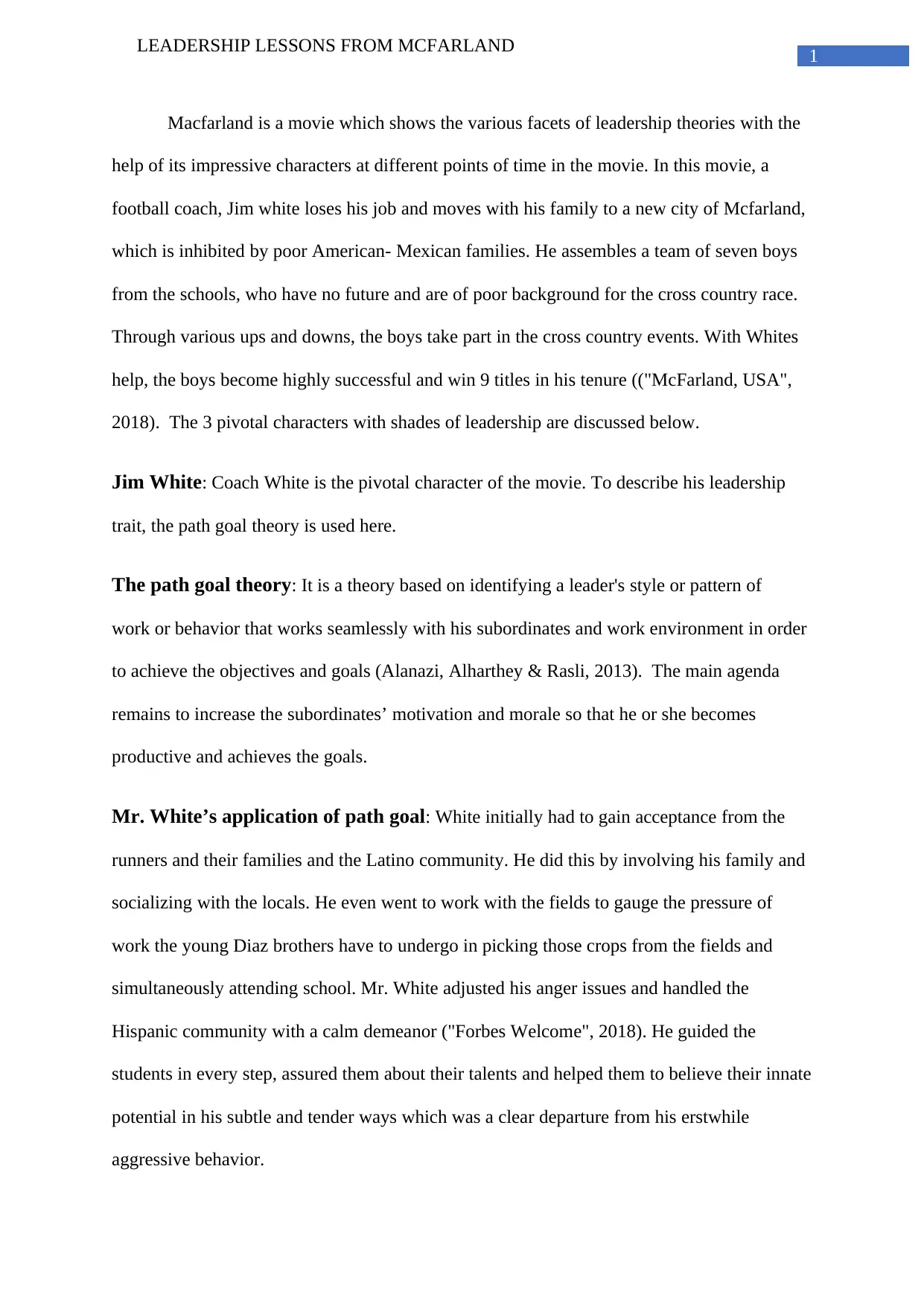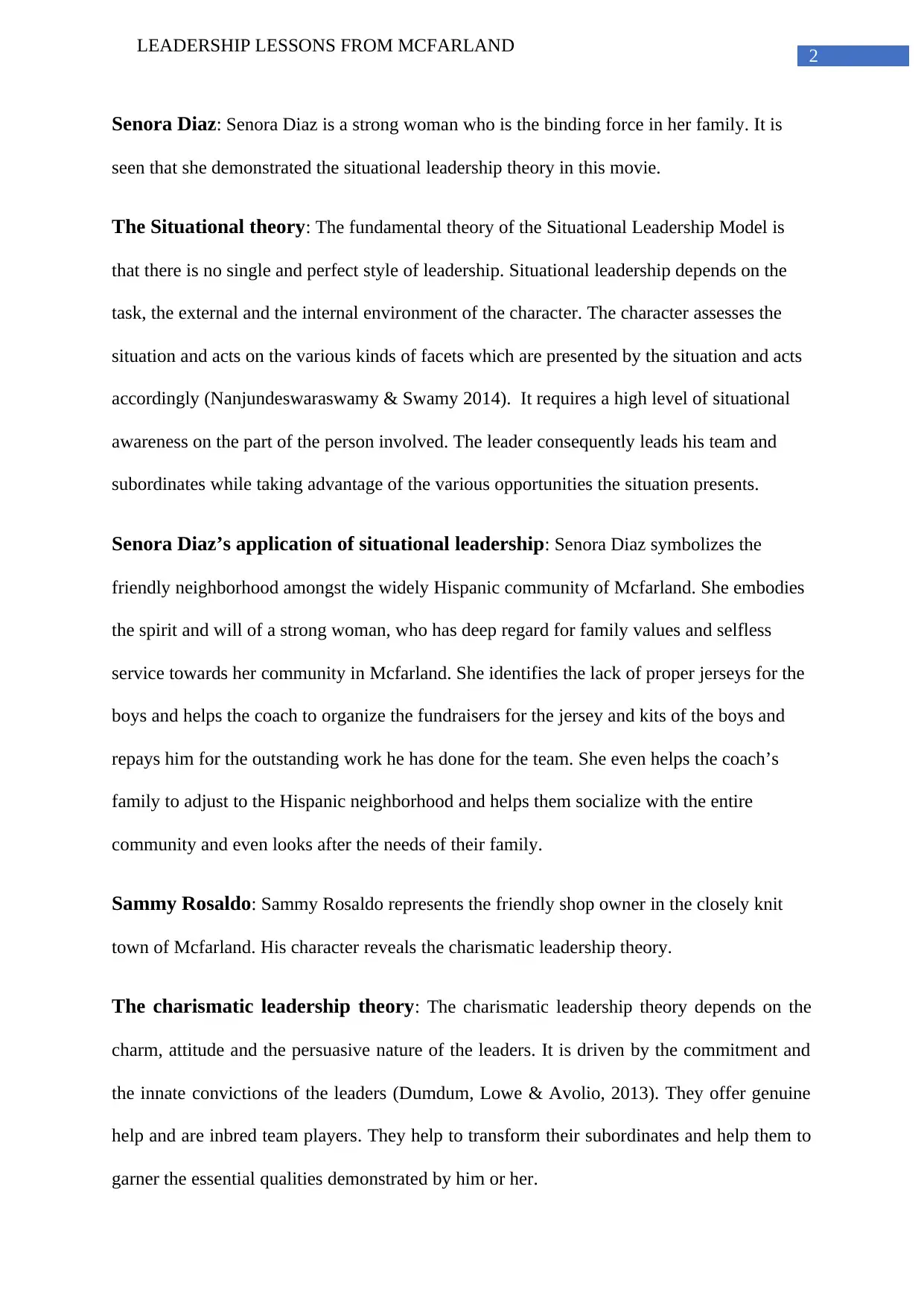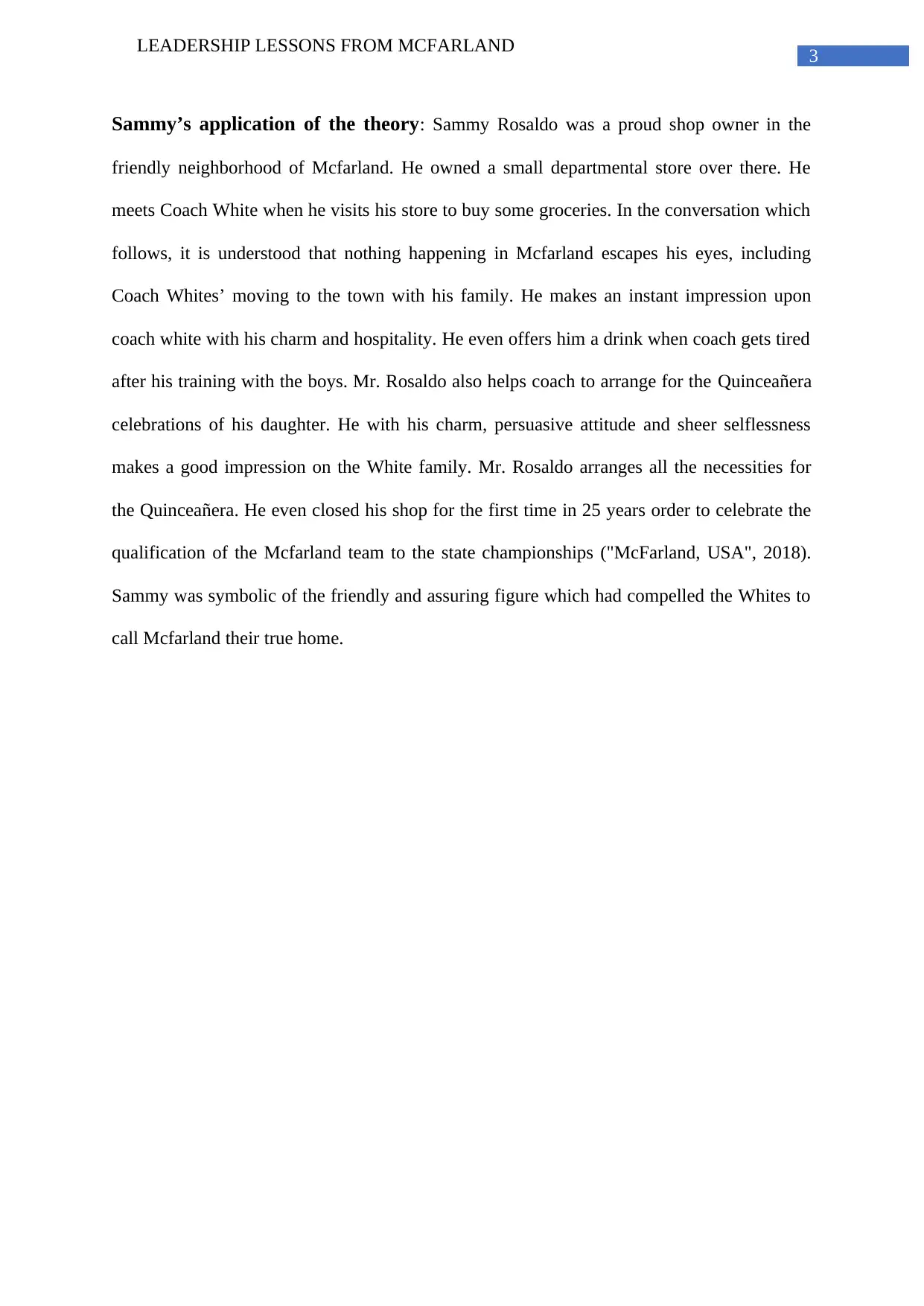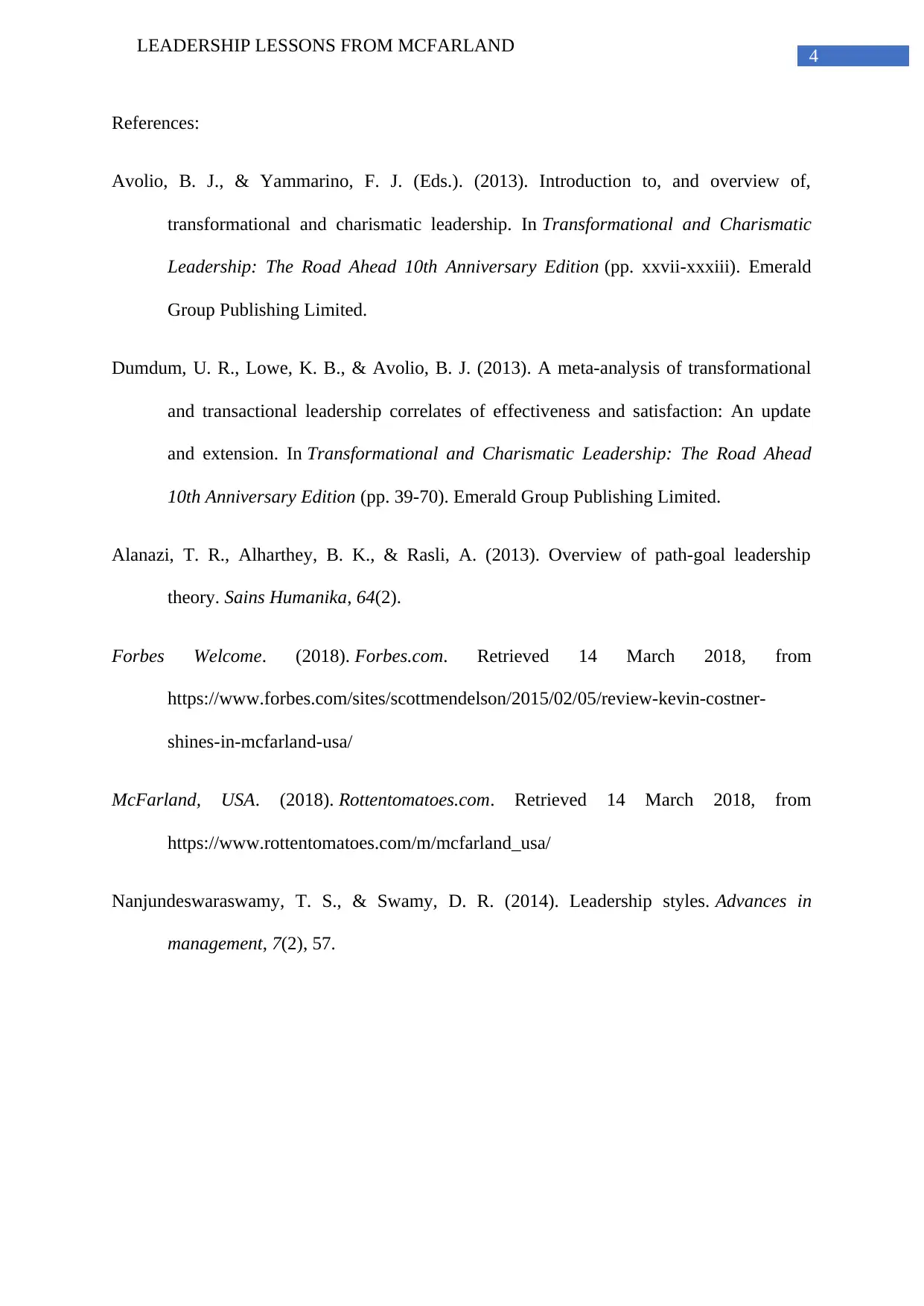Leadership Analysis: Exploring Leadership Theories in McFarland, USA
VerifiedAdded on 2021/04/17
|5
|1184
|24
Report
AI Summary
This report analyzes the movie "McFarland, USA" through the lens of leadership theories. The assignment focuses on three pivotal characters: Coach Jim White, Senora Diaz, and Sammy Rosaldo, and their application of different leadership styles. Coach White's leadership is examined using the path-goal theory, highlighting his ability to motivate and guide his team. Senora Diaz embodies situational leadership, adapting her approach to the needs of her community. Sammy Rosaldo's character is analyzed through the charismatic leadership theory, showcasing his charm and influence. The report delves into how these characters exemplify different leadership approaches and contribute to the team's success. The analysis highlights the practical application of leadership theories in a real-world scenario, providing insights into effective leadership styles. The report uses the movie to illustrate how different leadership styles can be applied in diverse situations to achieve common goals.

Running head: LEADERSHIP LESSONS FROM MCFARLAND
LEADERSHIP LESSONS FROM MCFARLAND
Name of the Student
Name of the University
Author note
LEADERSHIP LESSONS FROM MCFARLAND
Name of the Student
Name of the University
Author note
Paraphrase This Document
Need a fresh take? Get an instant paraphrase of this document with our AI Paraphraser

1
LEADERSHIP LESSONS FROM MCFARLAND
Macfarland is a movie which shows the various facets of leadership theories with the
help of its impressive characters at different points of time in the movie. In this movie, a
football coach, Jim white loses his job and moves with his family to a new city of Mcfarland,
which is inhibited by poor American- Mexican families. He assembles a team of seven boys
from the schools, who have no future and are of poor background for the cross country race.
Through various ups and downs, the boys take part in the cross country events. With Whites
help, the boys become highly successful and win 9 titles in his tenure (("McFarland, USA",
2018). The 3 pivotal characters with shades of leadership are discussed below.
Jim White: Coach White is the pivotal character of the movie. To describe his leadership
trait, the path goal theory is used here.
The path goal theory: It is a theory based on identifying a leader's style or pattern of
work or behavior that works seamlessly with his subordinates and work environment in order
to achieve the objectives and goals (Alanazi, Alharthey & Rasli, 2013). The main agenda
remains to increase the subordinates’ motivation and morale so that he or she becomes
productive and achieves the goals.
Mr. White’s application of path goal: White initially had to gain acceptance from the
runners and their families and the Latino community. He did this by involving his family and
socializing with the locals. He even went to work with the fields to gauge the pressure of
work the young Diaz brothers have to undergo in picking those crops from the fields and
simultaneously attending school. Mr. White adjusted his anger issues and handled the
Hispanic community with a calm demeanor ("Forbes Welcome", 2018). He guided the
students in every step, assured them about their talents and helped them to believe their innate
potential in his subtle and tender ways which was a clear departure from his erstwhile
aggressive behavior.
LEADERSHIP LESSONS FROM MCFARLAND
Macfarland is a movie which shows the various facets of leadership theories with the
help of its impressive characters at different points of time in the movie. In this movie, a
football coach, Jim white loses his job and moves with his family to a new city of Mcfarland,
which is inhibited by poor American- Mexican families. He assembles a team of seven boys
from the schools, who have no future and are of poor background for the cross country race.
Through various ups and downs, the boys take part in the cross country events. With Whites
help, the boys become highly successful and win 9 titles in his tenure (("McFarland, USA",
2018). The 3 pivotal characters with shades of leadership are discussed below.
Jim White: Coach White is the pivotal character of the movie. To describe his leadership
trait, the path goal theory is used here.
The path goal theory: It is a theory based on identifying a leader's style or pattern of
work or behavior that works seamlessly with his subordinates and work environment in order
to achieve the objectives and goals (Alanazi, Alharthey & Rasli, 2013). The main agenda
remains to increase the subordinates’ motivation and morale so that he or she becomes
productive and achieves the goals.
Mr. White’s application of path goal: White initially had to gain acceptance from the
runners and their families and the Latino community. He did this by involving his family and
socializing with the locals. He even went to work with the fields to gauge the pressure of
work the young Diaz brothers have to undergo in picking those crops from the fields and
simultaneously attending school. Mr. White adjusted his anger issues and handled the
Hispanic community with a calm demeanor ("Forbes Welcome", 2018). He guided the
students in every step, assured them about their talents and helped them to believe their innate
potential in his subtle and tender ways which was a clear departure from his erstwhile
aggressive behavior.

2
LEADERSHIP LESSONS FROM MCFARLAND
Senora Diaz: Senora Diaz is a strong woman who is the binding force in her family. It is
seen that she demonstrated the situational leadership theory in this movie.
The Situational theory: The fundamental theory of the Situational Leadership Model is
that there is no single and perfect style of leadership. Situational leadership depends on the
task, the external and the internal environment of the character. The character assesses the
situation and acts on the various kinds of facets which are presented by the situation and acts
accordingly (Nanjundeswaraswamy & Swamy 2014). It requires a high level of situational
awareness on the part of the person involved. The leader consequently leads his team and
subordinates while taking advantage of the various opportunities the situation presents.
Senora Diaz’s application of situational leadership: Senora Diaz symbolizes the
friendly neighborhood amongst the widely Hispanic community of Mcfarland. She embodies
the spirit and will of a strong woman, who has deep regard for family values and selfless
service towards her community in Mcfarland. She identifies the lack of proper jerseys for the
boys and helps the coach to organize the fundraisers for the jersey and kits of the boys and
repays him for the outstanding work he has done for the team. She even helps the coach’s
family to adjust to the Hispanic neighborhood and helps them socialize with the entire
community and even looks after the needs of their family.
Sammy Rosaldo: Sammy Rosaldo represents the friendly shop owner in the closely knit
town of Mcfarland. His character reveals the charismatic leadership theory.
The charismatic leadership theory: The charismatic leadership theory depends on the
charm, attitude and the persuasive nature of the leaders. It is driven by the commitment and
the innate convictions of the leaders (Dumdum, Lowe & Avolio, 2013). They offer genuine
help and are inbred team players. They help to transform their subordinates and help them to
garner the essential qualities demonstrated by him or her.
LEADERSHIP LESSONS FROM MCFARLAND
Senora Diaz: Senora Diaz is a strong woman who is the binding force in her family. It is
seen that she demonstrated the situational leadership theory in this movie.
The Situational theory: The fundamental theory of the Situational Leadership Model is
that there is no single and perfect style of leadership. Situational leadership depends on the
task, the external and the internal environment of the character. The character assesses the
situation and acts on the various kinds of facets which are presented by the situation and acts
accordingly (Nanjundeswaraswamy & Swamy 2014). It requires a high level of situational
awareness on the part of the person involved. The leader consequently leads his team and
subordinates while taking advantage of the various opportunities the situation presents.
Senora Diaz’s application of situational leadership: Senora Diaz symbolizes the
friendly neighborhood amongst the widely Hispanic community of Mcfarland. She embodies
the spirit and will of a strong woman, who has deep regard for family values and selfless
service towards her community in Mcfarland. She identifies the lack of proper jerseys for the
boys and helps the coach to organize the fundraisers for the jersey and kits of the boys and
repays him for the outstanding work he has done for the team. She even helps the coach’s
family to adjust to the Hispanic neighborhood and helps them socialize with the entire
community and even looks after the needs of their family.
Sammy Rosaldo: Sammy Rosaldo represents the friendly shop owner in the closely knit
town of Mcfarland. His character reveals the charismatic leadership theory.
The charismatic leadership theory: The charismatic leadership theory depends on the
charm, attitude and the persuasive nature of the leaders. It is driven by the commitment and
the innate convictions of the leaders (Dumdum, Lowe & Avolio, 2013). They offer genuine
help and are inbred team players. They help to transform their subordinates and help them to
garner the essential qualities demonstrated by him or her.
⊘ This is a preview!⊘
Do you want full access?
Subscribe today to unlock all pages.

Trusted by 1+ million students worldwide

3
LEADERSHIP LESSONS FROM MCFARLAND
Sammy’s application of the theory: Sammy Rosaldo was a proud shop owner in the
friendly neighborhood of Mcfarland. He owned a small departmental store over there. He
meets Coach White when he visits his store to buy some groceries. In the conversation which
follows, it is understood that nothing happening in Mcfarland escapes his eyes, including
Coach Whites’ moving to the town with his family. He makes an instant impression upon
coach white with his charm and hospitality. He even offers him a drink when coach gets tired
after his training with the boys. Mr. Rosaldo also helps coach to arrange for the Quinceañera
celebrations of his daughter. He with his charm, persuasive attitude and sheer selflessness
makes a good impression on the White family. Mr. Rosaldo arranges all the necessities for
the Quinceañera. He even closed his shop for the first time in 25 years order to celebrate the
qualification of the Mcfarland team to the state championships ("McFarland, USA", 2018).
Sammy was symbolic of the friendly and assuring figure which had compelled the Whites to
call Mcfarland their true home.
LEADERSHIP LESSONS FROM MCFARLAND
Sammy’s application of the theory: Sammy Rosaldo was a proud shop owner in the
friendly neighborhood of Mcfarland. He owned a small departmental store over there. He
meets Coach White when he visits his store to buy some groceries. In the conversation which
follows, it is understood that nothing happening in Mcfarland escapes his eyes, including
Coach Whites’ moving to the town with his family. He makes an instant impression upon
coach white with his charm and hospitality. He even offers him a drink when coach gets tired
after his training with the boys. Mr. Rosaldo also helps coach to arrange for the Quinceañera
celebrations of his daughter. He with his charm, persuasive attitude and sheer selflessness
makes a good impression on the White family. Mr. Rosaldo arranges all the necessities for
the Quinceañera. He even closed his shop for the first time in 25 years order to celebrate the
qualification of the Mcfarland team to the state championships ("McFarland, USA", 2018).
Sammy was symbolic of the friendly and assuring figure which had compelled the Whites to
call Mcfarland their true home.
Paraphrase This Document
Need a fresh take? Get an instant paraphrase of this document with our AI Paraphraser

4
LEADERSHIP LESSONS FROM MCFARLAND
References:
Avolio, B. J., & Yammarino, F. J. (Eds.). (2013). Introduction to, and overview of,
transformational and charismatic leadership. In Transformational and Charismatic
Leadership: The Road Ahead 10th Anniversary Edition (pp. xxvii-xxxiii). Emerald
Group Publishing Limited.
Dumdum, U. R., Lowe, K. B., & Avolio, B. J. (2013). A meta-analysis of transformational
and transactional leadership correlates of effectiveness and satisfaction: An update
and extension. In Transformational and Charismatic Leadership: The Road Ahead
10th Anniversary Edition (pp. 39-70). Emerald Group Publishing Limited.
Alanazi, T. R., Alharthey, B. K., & Rasli, A. (2013). Overview of path-goal leadership
theory. Sains Humanika, 64(2).
Forbes Welcome. (2018). Forbes.com. Retrieved 14 March 2018, from
https://www.forbes.com/sites/scottmendelson/2015/02/05/review-kevin-costner-
shines-in-mcfarland-usa/
McFarland, USA. (2018). Rottentomatoes.com. Retrieved 14 March 2018, from
https://www.rottentomatoes.com/m/mcfarland_usa/
Nanjundeswaraswamy, T. S., & Swamy, D. R. (2014). Leadership styles. Advances in
management, 7(2), 57.
LEADERSHIP LESSONS FROM MCFARLAND
References:
Avolio, B. J., & Yammarino, F. J. (Eds.). (2013). Introduction to, and overview of,
transformational and charismatic leadership. In Transformational and Charismatic
Leadership: The Road Ahead 10th Anniversary Edition (pp. xxvii-xxxiii). Emerald
Group Publishing Limited.
Dumdum, U. R., Lowe, K. B., & Avolio, B. J. (2013). A meta-analysis of transformational
and transactional leadership correlates of effectiveness and satisfaction: An update
and extension. In Transformational and Charismatic Leadership: The Road Ahead
10th Anniversary Edition (pp. 39-70). Emerald Group Publishing Limited.
Alanazi, T. R., Alharthey, B. K., & Rasli, A. (2013). Overview of path-goal leadership
theory. Sains Humanika, 64(2).
Forbes Welcome. (2018). Forbes.com. Retrieved 14 March 2018, from
https://www.forbes.com/sites/scottmendelson/2015/02/05/review-kevin-costner-
shines-in-mcfarland-usa/
McFarland, USA. (2018). Rottentomatoes.com. Retrieved 14 March 2018, from
https://www.rottentomatoes.com/m/mcfarland_usa/
Nanjundeswaraswamy, T. S., & Swamy, D. R. (2014). Leadership styles. Advances in
management, 7(2), 57.
1 out of 5
Your All-in-One AI-Powered Toolkit for Academic Success.
+13062052269
info@desklib.com
Available 24*7 on WhatsApp / Email
![[object Object]](/_next/static/media/star-bottom.7253800d.svg)
Unlock your academic potential
Copyright © 2020–2025 A2Z Services. All Rights Reserved. Developed and managed by ZUCOL.
